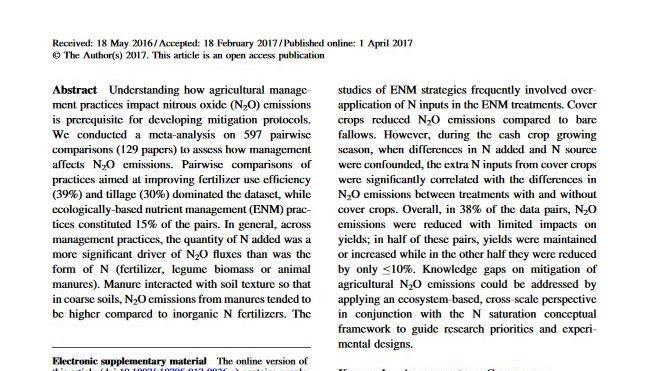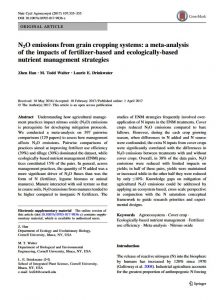Understanding how agricultural management practices impact nitrous oxide (N2O) emissions is prerequisite for developing mitigation protocols. We conducted a meta-analysis on 597 pairwise comparisons (129 papers) to assess how management affects N2O emissions. Pairwise comparisons of practices aimed at improving fertiliser use efficiency (39%) and tillage (30%) dominated the dataset, while ecologically based nutrient management (ENM) practices constituted 15% of the pairs. In general, across management practices, the quantity of nitrogen added was a more significant driver of N2O fluxes than was the form of nitrogen (fertiliser, legume biomass or animal manures). Manure interacted with soil texture so that in coarse soils, N2O emissions from manures tended to be higher compared to inorganic nitrogen fertilisers. The studies of ENM strategies frequently involved over-application of nitrogen inputs in the ENM treatments. Cover crops reduced N2O emissions compared to bare fallows. However, during the cash crop-growing season, when differences in nitrogen added and nitrogen source were confounded, the extra nitrogen inputs from cover crops were significantly correlated with the differences in N2O emissions between treatments with and without cover crops. Overall, in 38% of the data pairs, N2O emissions were reduced with limited impacts on yields; in half of these pairs, yields were maintained or increased while in the other half they were reduced by only ≤10%. Knowledge gaps on mitigation of agricultural N2O emissions could be addressed by applying an ecosystem-based, cross-scale perspective in conjunction with the nitrogen saturation conceptual framework to guide research priorities and experimental designs.
Region: Not specific
Date published:
2017
Published by:
Nutrient Cycling in Agroecosystems
Type of resource:
Journal article
Resource topic:
Greenhouse gas emissions
Project/Programme: Not specific
Pest/Disease: Not specific
Pages:
21
File type:
(920 KB)




